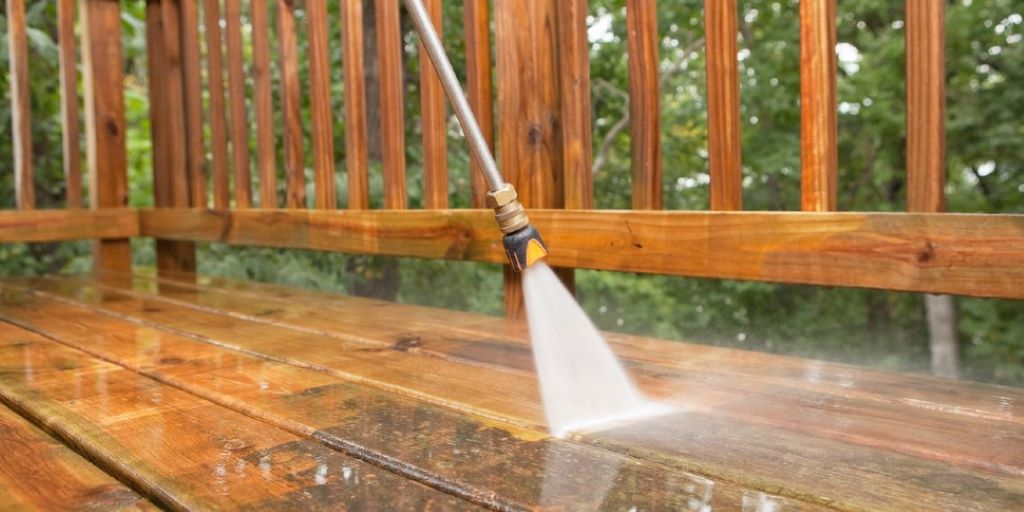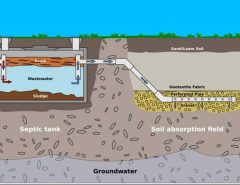After investing time and money into pressure washing your deck, you’ll want to protect and beautify your wood by applying stain. However, it’s essential to wait for the right amount of time before applying stain, or you could end up with peeling, fading, or otherwise ineffective results. This comprehensive guide will examine all the factors determining how long to wait to stain deck after pressure washing.
Why You Should Wait Before Staining After Pressure Washing
When you pressure wash a deck, the high-powered water blast removes mold, mildew, dirt, and other debris by force. This prepares the wood for staining by getting it clean and dry. However, pressure washing also opens up the wood grain slightly. If you spoil too soon, the open wood pores will absorb more stains than average. This can lead to the finish becoming gummy or sticky.
It would be best to wait for the deck to be fully dry before applying the stain. Most stains require a surface moisture content below 15% before application. Pressure washing forces water deep into the wood fibers. This moisture needs sufficient time to evaporate so the stain can adequately cure.
Finally, waiting allows the wood to return to its natural state after being disturbed by the intense pressure washing. This allows the stain to penetrate evenly for consistent coloring and protection. Rushing to stain after cleaning can lead to uneven absorption and splotchy or blotchy results.
Factors That Determine How Long to Wait

Several key factors impact the drying time and determine how long you should wait before applying stain after pressure washing a deck:
Type of Wood
The type and age of the deck wood impact how long it takes to dry out after power washing. New pressure-treated lumber like pine dries faster than older, dense hardwoods like ipe or mahogany. Softwoods like cedar and redwood also take less time to dry than hardwoods. More aged wood that has been weathered and cracked absorbs more water and needs more drying before staining.
Weather Conditions
Environmental conditions play a massive role in drying time. Decks dry faster when it’s sunny, warm, dry, and breezy than when it’s cool, cloudy, humid, and still. Colder temperatures and high humidity prolong the dry time. Heat and arid climates speed up the drying process. Pay close attention to the weather after pressure washing to gauge the drying timeline.
Level of Exposure
Decks uncovered with direct sun exposure dry faster than covered or shaded decks after cleaning. Southern exposures that get sunlight most of the day will be ready for staining sooner than northern exposures that only get partial sun. Semi-covered decks take longer to dry out than complete open decks.
Thoroughness of Cleaning
The intensity and comprehensiveness of the pressure washing process impact drying time. A light surface spray dries faster than an aggressive deep cleaning blast. High-pressure levels and unique deck cleaning detergents force more water into the wood, extending the drying period. The more thorough the cleaning, the longer the wait.
Existing Finish
If staining over a previously sealed deck, the existing finish affects the dry time. Old semi-transparent stain allows the wood to dry faster than solid opaque stains that create a moisture barrier. Finishes that are peeling or flaking absorb and hold more water. Removing all old coating to bare wood results in the quickest drying deck.
Read Also: How to Clean Fabric Blinds?
Recommended Waiting Times
With all these factors in play, knowing exactly how many days to wait before applying stain can be tricky. Here are some general guidelines for recommended waiting times:
- New pressure-treated softwood deck – 2 to 3 days
- Old weathered softwood deck – 4 to 5 days
- New hardwood deck – 5 to 7 days
- Old hardwood deck – 7 to 10 days
In ideal warm, sunny, and breezy conditions, these times can often be cut in half. Add two or more days during cool, humid, or still weather. Wait 14 days before staining a previously sealed deck, and allow complete drying after rain.
Performing a simple moisture test by sprinkling a few drops of water on the deck and timing how long it takes to absorb can confirm if the deck is ready for staining. If the water beads and doesn’t absorb within 5 minutes, the deck needs more time to dry out sufficiently.
Tips for Drying Your Deck Quickly
Here are some handy tips to help speed up the drying process after pressure washing so your deck is ready for staining sooner:
- Pressure washing in the morning allows the deck maximum sun exposure to dry during the day.
- Use fans – Set up fans right after cleaning to circulate air across the wet deck surfaces. Box or oscillating patio fans work great for this.
- Break out the leaf blower – Carefully blow air across the top and bottom of deck boards to accelerate drying. Don’t disturb neighbors!
- Cover at night – Cover the deck overnight with transparent plastic drop cloths to protect it from rain and dew that will re-wet the wood and delay drying.
- Check hidden areas – Inspect vertical surfaces and under railings and ledgers since these spots stay wet longer. Allow extra time for these areas to dry before staining.
- Consider spacing boards – For severely wet solid surface decks, use small spacers between boards to increase air circulation and allow faster drying.
- Wait for ideal weather – Pay close attention to weather forecasts and hold off on pressure washing until hot, dry, sunny conditions are expected for several days to speed up drying.
What Happens If You Stain Too Soon?
It can be tempting to ignore the recommended dry times and stain the deck right after cleaning, but this often leads to problems. Here are some issues you may encounter if staining before the deck is fully dry:
- Uneven coloring – Damp areas absorb more stains and become darker than dry spots, leading to a blotchy appearance.
- Stickiness – Excess moisture makes the stain tacky and gum up when applying tools and walking on the deck.
- Bubbling or peeling – Trapped moisture tries to escape through the stain, causing it to bubble and peel off the deck.
- Warping or swelling – Water caught under staining can cause deformities as the deck expands and contracts during drying.
- Discoloration – Extended moisture contact under the stain causes tannin bleed, mold, and other aesthetically displeasing staining.
- Shortened life span – Improper adhesion and curing will break down the protective stain coating sooner and require more frequent reapplication.
Maintaining Your Stained Deck
Once your deck is finally stained after the appropriate dry time, you’ll want to keep it looking its best. Here are some tips for maintaining a stained deck:
- Reapply fresh stain every 1-2 years for optimal protection and appearance.
- Lightly sand the deck with 80-100 grit sandpaper before re-staining to help adhesion.
- Keep the deck surface free of leaves, dirt, and debris that can lead to mold and mildew growth under the stain.
- Mitigate standing water and wetness from sprinklers that can infiltrate the stain coating.
- Test stain compatibility if switching brands to avoid adhesion issues.
- Consider alternating between oil-based and water-based products for maximum penetration.
- Repair any damaged boards, loose nails, or splintering that can worsen under sealing.
Proper prep work, waiting for complete drying, high-quality application techniques, and routine upkeep will keep your stained deck looking new for many years. Check out our complete deck maintenance guide for more helpful tips.
Frequently Asked Questions
How long should pressure-treated wood dry before staining?
For new pressure-treated pine, wait 2-3 days after pressure washing if the weather is warm, sunny, and breezy. Before staining, wait five days or more in cool, damp, or humid conditions.
Can you stain wood right after pressure washing?
It’s not recommended to stain immediately after pressure washing. The wood needs time to dry out and return to equilibrium after being saturated from cleaning. Wait at least two days for softwoods and five days for hardwoods.
Is pressure-washed wood too wet to stain?
Wood is often too wet to absorb stains properly after pressure washing. Use a moisture meter or water sprinkle test to determine if the wood surface moisture content is below 15% before applying the stain.
How long after rain can you stain a deck?
After rain, allow 1-2 full days of dry weather before staining a deck. More drying time is needed for heavy rainfall that saturates the wood. Smearing over damp wood often causes bubbling issues.
What happens if you stain wood too soon?
Staining before the deck is fully dry can lead to a gummy texture, uneven coloring, peeling, warping, discoloration, mold growth, and other problems that shorten the lifespan of the protective finish.
Conclusion
You know how long to wait to stain the deck after pressure washing, which is critical for proper penetration and curing. While drying times vary based on wood type, weather, and other factors, allow at least 2-3 days for softwoods and 5-7 days for hardwoods in ideal conditions. Perform a moisture test to confirm the deck is ready for staining. Don’t rush the process; you could end up with a blotchy, peeling mess and have to start all over again. With some planning and patience, you can successfully revitalize and protect your deck with a beautiful, long-lasting stain.




